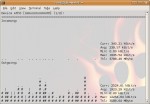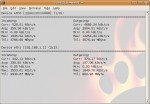nload, a network traffic analyser
nload is a ncurse based network traffic analyser. Being a ncurse based tools, you do not need to start X in order to use that software which is necessary when administering machines remotely … and even locally actually.
nload allow a system administrator to easily monitor the traffic going on its network. It provide both a graph of incoming and outgoing traffic as well as network data transfert statistics.
nload can be used straightforward by typing:
$ nload
Once nload is started, you can exit the interface by typing either q or Ctrl-c.
By default, nload will display incoming and outgoing traffic in kBit/s and use eth0 as default network interface on a linux system, fxp0 on BSD, hme0 on Solaris and lan0 on HP-UX.
Monitoring more than 1 network interface:
If you want to monitor more than on interface, or another one than the default one, you need to supply the network interface names at the end of the command, so for intance, if you want to monitor eth1 and lo, type:
$ nload eth1 lo
you can then navigate from a network interface to another by using the following key shortcut:
To go to the:
- next interface use any of the following keys: ArrowRight, ArrowDown, PageDown, Enter, Tab or n
- previous interface: ArrowLeft, ArrowUp, PageUp or p
Some people might prefer to see all the devices status together in the same window. In that case, simply use the -m switch like this:
$ nload -m eth1 lo
You can then use the previous key shortcuts to go to the previous and next pages if all the interfaces could not fit in a single window.
Options to use with nload
nload comes with a bunch of switches which allow you to customize the output given by nload.
You can customize the 100% mark of the incoming bandwidth using -i XXX (where XXX is given in kBits/s) or -o YYY for outgoing traffic, default is 10240.
Change the interval of update is done by adding -t SSS (where SSS is the time in milliseconds), default is 500 ms.
To change the type of unit displayed for the traffic numbers use -u h|b|k|m|g for human, bits, kilo, mega or giga bits, using H|B|K|M|G will make the output type being in Bytes, default is k.
-U will do the same but for the amount of data, default is M.
Let see some examples.

